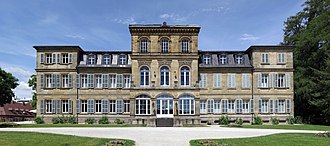Fantaisie Castle
The Fantaisie Palace is in the district Donndorf the municipality Eckersdorf , five kilometers west of Bayreuth . It was built as another summer residence (after the Hermitage ) for the margrave couple Friedrich and Wilhelmine of Brandenburg-Bayreuth . The garden art museum is set up in the palace building . A large park belongs to the castle.
history
During an almost one-year trip to Italy in 1754/55, the margrave couple gathered impressions (including at the Villa Doria Pamphilj in Rome ), which they implemented in the Fantaisie Castle. Construction began in 1758, but was soon interrupted because Wilhelmine died that same year at the age of 49. Friedrich continued the construction in 1761. He couldn't see the completion either. He died in Bayreuth in 1763 at the age of 51.
The daughter of the margrave couple, Princess Friederike , inherited the property in 1763. The name Fantaisie comes from her . She had the castle completed by Johann Jakob Spindler by 1765 . It houses the Spindler Cabinet, an inlay work by the brothers Johann Friedrich and Heinrich Wilhelm Spindler in a faithful replica of the original, which is located in the Bavarian National Museum in Munich .
After Friederike's death in 1780, the palace and park were sold. In 1792 her cousin Friederike Dorothea Sophia von Brandenburg-Schwedt (1736–1798) bought the property. Together with her husband, Duke Friedrich Eugen von Württemberg (1732–1797), she had the park Anglicized. Her grandson Alexander Friedrich Wilhelm (1804–1881) increased the size of the palace and had the garden decorations renewed in line with contemporary tastes. He lived there with his second wife Emilie von Meyernberg, a formerly middle-class girl whom he had bought from her husband in Frankfurt , in a " left-hand marriage ". At that time, the palace's administrator was his court cavalier, Werner von Droste zu Hülshoff, a grandson of the composer Maximilian Friedrich von Droste zu Hülshoff .
In October 1938, the Reich School of the National Socialist Teachers' Association was opened in Fantaisie Palace. A month later the general command of the newly founded Sudeten German Freikorps , a paramilitary unit made up of Sudeten German men, was housed in the palace.
Due to the later renovations, very little of the original castle has survived. In July 2000, Germany's first garden art museum was set up in the palace building.
The palace park is characterized by elements from the style phases Rococo , Sensitivity , Romanticism and Historicism . The park has been returned to its original state. The south-facing terraces facing the lake were planted with vines again, the labyrinth was laid out again and the water cascades were repaired with sandstone shells and mythical creatures.
literature
- Johann Kaspar Bundschuh : Fantaisie . In: Geographical Statistical-Topographical Lexicon of Franconia . tape 2 : El-H . Verlag der Stettinische Buchhandlung, Ulm 1800, DNB 790364298 , OCLC 833753081 , Sp. 119-120 ( digitized version ).
- Kai Kellermann : Stately gardens in Franconian Switzerland - a search for traces . Palm and Enke Verlag , Erlangen and Jena 2008, ISBN 978-3-7896-0683-0 , pp. 227-229.
- August Gebeßler : City and district of Bayreuth (= Bavarian art monuments . Volume 6 ). Deutscher Kunstverlag, Munich 1959, DNB 451450914 , p. 101-104 .
Web links
- Entry with the Bavarian Administration of State Palaces, Gardens and Lakes
- www.gartenkunst-museum.de
- Fantaisie Castle in the location database of the Bavarian State Library Online . Bavarian State Library
Individual evidence
- ↑ My trip to Italy. www.wilhelmine-von-bayreuth.info, 2018, accessed on March 31, 2018 .
- ↑ Wilhelmine von Bayreuth and antiquity: To Italy, to Italy. Back then , October 20, 2004, accessed March 31, 2018 .
- ↑ BR.de : Women of the 18th century (1): Princess Wilhelmina of Brandenburg-Bayreuth , accessed on 31 March 2018th
- ↑ Eckersdorf / Donndorf - Fantaisie Castle: Changing owner history. www.markgrafenkultur.de, 2018, accessed on March 31, 2018 .
- ↑ Eva-Maria Bast , Heike Thissen : Bayreuth Secrets . 1st edition. Bast Medien Service, Überlingen 2014, ISBN 978-3-9816796-1-8 , p. 155 f .
- ↑ Wilderich von Droste zu Hülshoff : 900 years Droste zu Hülshoff , p. 253.
- ↑ Bernd Mayer : Bayreuth in the twentieth century , p. 71.
- ↑ Garden Art Museum. Bavarian Administration of State Palaces, Gardens and Lakes , 2018, accessed on March 31, 2018 .
Coordinates: 49 ° 56 ′ 1.4 ″ N , 11 ° 30 ′ 32.8 ″ E





